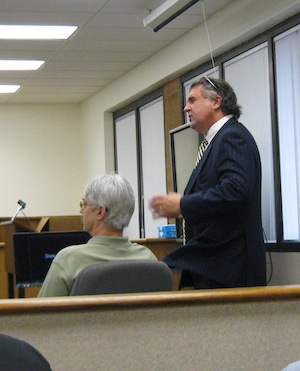
Defense lawyer John Crowley gives his closing arguments in Ricky Riffe’s murder trial.
By Sharyn L. Decker
Lewis County Sirens news reporter
CHEHALIS – Ricky A. Riffe’s lawyer gave his closing arguments yesterday telling the jury hearing the 1985 double-murder case that if they followed the rules given to them, they would see there was no real evidence against his client and they would acquit him.
John Crowley pointed to the fear that gripped the community nearly 30 years ago when the elderly couple vanished from their home in Ethel and turned up shot to death off a logging road outside Adna.
It caused folks to sleep with guns and warn their children, Crowley said. As professional as they were, even the police were affected by it, he said.
“Fear is illogical, it knows nothing about time,” Crowley said.
The key instructions the jury must look at, he said, are the presumption of innocence and reasonable doubt.
Checking the ‘guilty’ box requires that jurors can, with conviction, walk out of the courthouse and say his client did it, he said.
The Seattle-based attorney spoke for about four hours in Lewis County Superior Court after five weeks of testimony and more than 600 items were presented as physical evidence.
He repeatedly offered the phrase, “false evidence appearing real.”
What prosecutors presented did not connect his client to it, Crowley said, although there were many appearances it did.
“Thirty years plus six weeks of trial, it is obvious nobody knows what happened,” he said. “Nobody.”
Riffe, 55, is charged with numerous offenses in connection with December 1985 deaths of Ed and Minnie Maurin. He and his now-deceased younger brother have been the prime suspects since the early 1990s but he was only arrested last year.
Crowley spoke in partial sentences and run-on sentences, from his podium he placed next to his client.
He moved from topic to topic and back again in a courtroom in which eight family and friends sat behind the defense table while about 30 spectators crowded onto the benches behind prosecutors.
Crowley laced his recitation with phrases including the words “friendly”, “hostile”, “scammer” and “invader” in apparent reference to whomever took the Maurins. He spoke of witnesses who have been “cued” for nearly 30 years.
Why do they keep saying sawed off shotgun, he asked. What witness actually saw the sawed off shotgun?
Government is a structure run by people with resources and personalities, he told the jury.
“When it says a sawed off shotgun was used, you believe it, it’s human nature,” Crowley said.
He pointed out witnesses who saw a man around Yard Birds – where the Maurin’s bloody car was found – who spoke of a long gun.
“Make them prove it, make them do something they cannot do, which is prove beyond a reasonable doubt,” he said. “Because at the end, Rick is entitled to an acquittal.”
Prosecutors made it sound as though his client was kind of a freeloader, he said, but he was a logger who was hurt on the job, he told the jury.
“He also consumed some amount of drugs, but we don’t know how much,” he said.
Crowley said his client’s friend Les George seemed like a hardworking guy, and it sounded as though he was a suspect at one point, he noted.
Why would Riffe rip the page out of the registration book at Sunbirds when George bought his gun there, and how much did it even mean if it happened 14 months before the homicides, he asked. If it even happened, he added.
As for the burglary at the Maurin’s home, there’s no evidence how entry was made, he said.
“There was real evidence,” he said. “There was the purse between the couch and that wall, but it doesn’t take you down any path.”
Crowley re-characterized his client’s answers to law enforcement as similar to anyone else who is asked about events from perhaps six years earlier from a day that had no significance.
His client did ask his brother-in-law if shotgun shells could be traced, he said. But they were also talking about goose hunting, and he had a felony conviction which meant he shouldn’t handle firearms, he said.
Crowley showed the jury pictures of his client taken during that summer, and on Christmas Day, claiming his beard couldn’t match up with the few days growth of facial hair described by witnesses.
He listed the various purchases prosecutors implied the Riffe brothers made with the proceeds of the crime, suggesting $8,500 couldn’t be stretched that far.
“They nailed Rick at White Pass on Dec. 19 doing a drug deal,” he said. “But remember, (Jeff) McKenzie had him at the AM/PM that night.”
He pointed out no physical evidence linked Riffe to the crimes. No DNA, no hair, no fiber, no trace evidence, nothing, he said.
And where is the registration or any sales document for a supposed white car Riffe owned, he asked.
Early in the investigation, when photos were shown and nobody was picked, the detectives didn’t record it, he told the jury. So nobody knows how many people looked at his client’s face and didn’t choose it, he said, when their memories were fresher.
Crowley kept speaking of how unreliable people’s memories are, noting that witnesses who picked Riffe from a montage made their choice 9,835 days after the homicide.
“I should say this,” he said. “Those witnesses are not lying, they are gripped with fear.”
Adna resident William Reisinger testified the Maurin’s sedan was speeding down Bunker Creek Road at 11:35 a.m. on Dec. 19, 1985, he said.
And former Lewis County Sheriff’s Office Deputy Billy Forth – who testified he saw the same car and identified both Riffe and his brother as the lone driver – was already back at the courthouse looking at his watch at 11:10 a.m., he said.
“He’s not lying,” Crowley said. “He’s a mistaken witness that blamed himself.”
Crowley reminded the jury of the long list of witnesses at or passing through Ethel that morning who told of how foggy it was and of the ones who saw the Maurins in their green car with another person.
The one person who said they saw a fourth person in the vehicle was adamant that happened on a clear day, he said.
Jason Shriver was 17 years old and on the way with his mother to a dental appointment, and the “split second” look he got at the Riffe brothers in a car probably occurred, Crowley said.
Crowley suggested Shriver’s memories were jumbled by time and emotion, and the narcotics he was given after his oral surgery.
“Whatever day this was, it undoubtedly was not Dec. 19,” he said.
According to the defense attorney, Frank Perkin’s testimony was preposterous. Marty Smeltzer’s was nonsense. Witness Gordon Campbell is like Erwin Bartlett in that he knew he wasn’t telling the truth, he said.
Campbell is the kind of person who thinks if someone is charged they must be guilty, he claimed. Bartlett committed perjury, he said.
Why is the prosecution even offering witnesses like that, Crowley asked the jury.
“Because fear knows no bounds, it has caught them,” he said.
His client had nothing to do with it, he concluded.
“Rick did not do this, there’s no real evidence he did this,” Crowley said, raising his voice. “He’s entitled to an acquittal based on real evidence, not perjury.”
The jury of eight women and four men was sent to begin deliberating shortly before 5 p.m., but chose to go home at 5:30 p.m. and return this morning to continue.
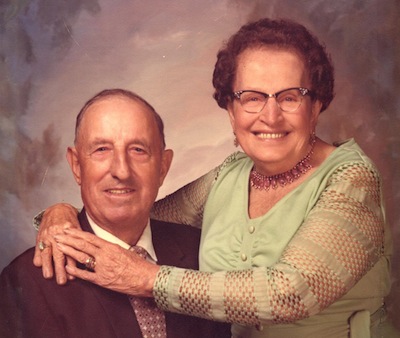
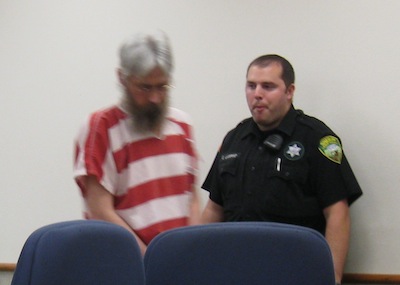

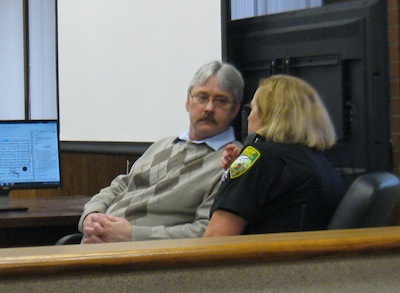
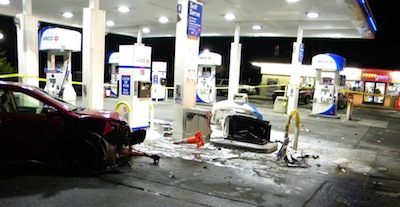
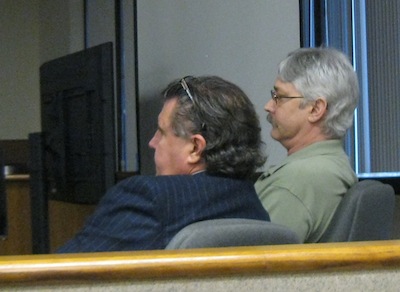
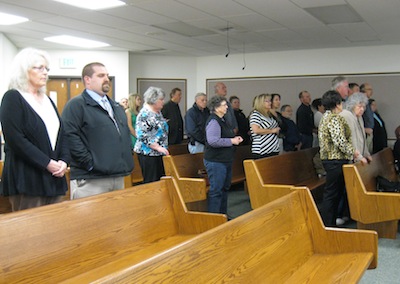

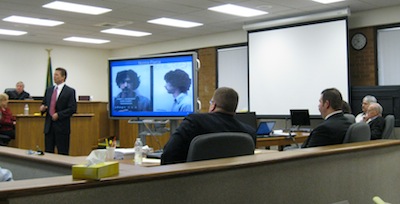
 Join us
Join us